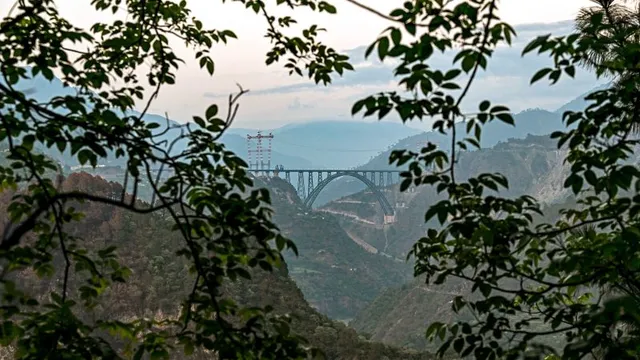
Modi inaugurates world's highest railway bridge amidst regional tensions
2025-06-06 00:00- Prime Minister Narendra Modi inaugurated the Chenab Bridge in Kashmir, standing at 359 meters high.
- The bridge is part of a larger effort to enhance connectivity between Kashmir and the rest of India following increased military tensions.
- Modi's administration claims such infrastructure investments will foster stability and national integration in the region.
Express your sentiment!
Insights
On Friday, Indian Prime Minister Narendra Modi visited the region of Jammu and Kashmir to inaugurate the Chenab Bridge, the world’s highest railway bridge, which is part of an ambitious railway project aimed at connecting Kashmir with the rest of India. This event came shortly after a deadly tourist massacre that escalated tensions between India and Pakistan, leading to conflict earlier in April, where both countries engaged in missile and artillery exchanges. Modi's visit marked his first since the spike in violence and aimed to bolster infrastructure development in the contentious area. The Chenab Bridge, standing 359 meters above the river, is a significant engineering achievement, surpassing the Eiffel Tower in height by over 29 meters. The construction of the bridge follows years of planning and investment, with costs exceeding $160 million. It stretches a total of 1,315 meters and signifies the initial steps towards establishing a railway link that will enhance connectivity in an area that has historically been difficult to access due to its geographical and political challenges. This project is part of Modi’s broader initiative to integrate the predominantly Muslim region with the Indian mainland. In addition to the bridge, Modi also inaugurated the Udhampur-Srinagar-Baramulla Rail Link project, which links major cities in Indian-administered Kashmir to other parts of India. This infrastructure drive is viewed as a strategy by Modi's Bharatiya Janata Party government to promote stability and economic growth in the region. Since taking office, Modi has emphasized the need for improved transport networks across India, especially in remote and underdeveloped areas such as Kashmir. However, this development has attracted criticism from environmentalists, raising concerns over the ecological impact of such extensive construction in the fragile Himalayan ecosystem. Critics warn that the extensive infrastructure projects could exacerbate the existing effects of climate change on the region. Despite these concerns, Modi’s administration maintains that such investments are vital for achieving long-term growth and stability in Kashmir, an area claimed by India, Pakistan, and China. The Chenab Bridge, therefore, highlights both the engineering prowess of India and the ongoing geopolitical complexities that define the relationship between India and its neighbors.
Contexts
The Kashmir conflict has been a longstanding territorial dispute primarily between India and Pakistan since the end of British colonial rule in 1947. Initially, the princely state of Jammu and Kashmir was ruled by Maharaja Hari Singh, who faced pressure from both India and Pakistan as the two newly independent nations sought control over the region. The situation escalated into the first Indo-Pakistani war in 1947-1948, leading to a UN-mediated ceasefire in 1949, which resulted in the establishment of the Line of Control (LoC) that split the region into areas administered by both countries. The conflict has persisted through various wars, skirmishes, and political struggles, impacting millions of lives and contributing to a protracted humanitarian crisis. Over the years, several rounds of talks and diplomatic efforts have been made to resolve the dispute, but a lasting solution remains elusive. Both India and Pakistan claim the entirety of Kashmir, but each controls only a portion of it. India's administration of Jammu and Kashmir has undergone significant changes, especially with the abrogation of Article 370 in August 2019, which revoked the special autonomy previously granted to the region. This move has led to increased tensions in the area, with Pakistan vehemently opposing the change and calling it a violation of international laws. Meanwhile, India has maintained that the move is an internal affair aimed at integrating Jammu and Kashmir more closely with the rest of the country. The repercussions of the conflict extend beyond bilateral relations, influencing regional stability in South Asia. Periodic violence and unrest in Kashmir, including militant activity and civil disobedience, have heightened security concerns for both countries and caused international concern as well. The situation has drawn the attention of global powers, who often call for dialogue and peace but remain cautious about becoming directly involved due to the nuclear capabilities of both India and Pakistan. Human rights organizations have also expressed alarm over reports of abuse and violations in the region, further complicating the potential for peace. As of June 2025, the Kashmir conflict continues to be a flashpoint in India-Pakistan relations, with sporadic violence still emerging in the region, alongside ongoing military and paramilitary presence. Efforts to revitalize dialogue appear stalled, and the general sentiment among the local populace remains one of disillusionment and unrest. For any future negotiations to succeed, addressing the deep-rooted historical grievances and ensuring the rights and aspirations of the people of Kashmir would be fundamental. Without sustained diplomatic engagement and genuine efforts towards reconciliation, the likelihood for peace in the region remains low, perpetuating the cycle of conflict.